Translation in english available at the bottom
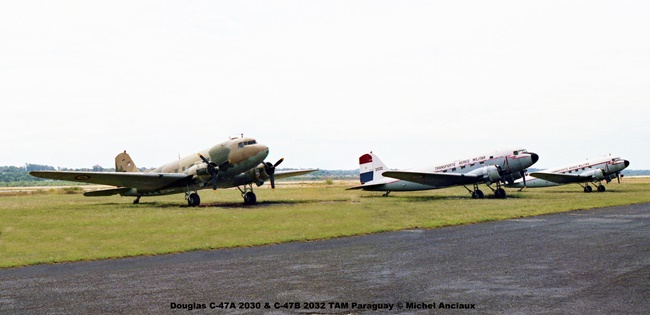
TAM (Transporte Aéreo Militar) de Paraguay es une rama de la Fuerza Aerea Paraguay que fue fundado a la fecha del 10 de marzo de 1954, operando inicialmente con un solo avión de tipo Douglas DC-3.
El 16 de marzo, el mencionado DC-3 con código militar T-21 realizó el primer vuelo, a la ciudad de Pedro Juan Caballero, ubicada a unos 451 km al noreste de la capital Paraguay y cerca de la frontera con Brasil. A lo largo del primer año de operación, vuelos fueron también iniciados a ciudades de Concepción, Filadelfia (en el Chaco) y Encarnación.
Con el aumento de los vuelo fue necesario adquirir más materiales y en 1955 dos DC-3A (T-23 y T-25), un C-47A/B (T-27) así que un R4D-1 ((T-35) ingresaron a la flota de TAM permitiendo así aumentar el transporte de pasajeros, cargas y correos.
Es de saber que además de sus vuelos regulares a las distintas ciudades del país, TAM operaba también vuelos identificados como de acción cívica de transportes de víveres, medicamentos, semillas y maquinarias agrícolas de menor porte a los diversos asentamientos campesinos, sin olvidare las evacuaciones medicales.
Con los años, más C-47 fueron inscritos en los registros de TAM sea a través del Military Aid Program americano o por donaciones de los gobiernos de Brasil, Argentina y Chile y a lo largo de los 50 años de operaciones de este mítico avión, 34 modelos DC-3, C-47 y RD4 llegaron a volar en TAM (27 C-47, 6 DC-3 y 1 R4D).
Pero se tuvo que lamentar 8 accidentes con tres víctimas fatales.
El primero fue en 1965 cuando el C-47 T-25 se incendió en la losa del aeródromo de Encarnación, en una operación de reabastecimiento de combustible. El segundo ocurrió el 2 de junio de 1965 con el T-49, cuando en un vuelo desde Asunción a Pedro Juan Caballero los 2 motores fallaron necesitando un aterrizaje de emergencia en terreno abierto. A consecuencia del destrozo de la cabina de mando falleció instantáneamente el piloto al mando, capitán Martínez Duarte.
El siguiente accidente ocurrió el 27 de agosto de 1980 con el 2016 luego de despegar en un vuelo con destino a Yacyretá (Misiones). Debido a problemas con los motores, el piloto intento volver al aeropuerto internacional de Asunción pero al perder altura se estrelló contra una casa en Lambaré cobrando la vida del Mayor PAM Acuña Ramírez.
El cuarto accidente fue el 1 de mayo de 1984, al despegar de Concepción con el 2019. Una falla de los motores obligó el piloto a realizar un aterrizaje de emergencia, sin víctimas fatales tanto para la tripulación de abordo que para los 21 pasajeros.
En 1987, dos accidentes adicionales resultaron en la perdida de materiales pero sin víctimas fatales. Se tratan del 2008 en Bahía Negra y el 2034 en Lagerenza.
En el año 1994 ocurrieron los dos últimos accidentes con los Douglas C-47. El 26 de septiembre en un vuelo desde Bahía Negra a Asunción, el 2009 salió de la pista mientras iniciaba su despegue. Debido al impacto con el terreno, la hélice del motor izquierda penetro el fuselaje a altura de la cabina de mando matando el piloto Mayor PAM Lezcano. Él fue la última víctima fatal de TAM en los 50 años de operaciones del C-47.
El último accidente ocurrió el 24 de noviembre con el 2028, al despegar de Puerto la Victoria, con destino final la ciudad de Asunción. Los daños resultaron en su baja de servicio.
A mediano de los años 70, las autoridades consideraron las posibilidades de reemplazo del bimotor C-47. Uno de los proyectos que fue a punto de finalizar era la propuesta de la Israel Aircraft Industries con su modelo 201 “Arava”. Hasta un pedido para seis aviones fue iniciad, con posible entregas a partir de Marzo de 1977. Pero a solo un mes de esta fecha el gobierno paraguayo cancelo el contrato.


Pero fue en 1984 que se realizó la compra de cuatro C.A.S.A. C-212-200 Aviocar.

También, en 1994 se estudió las posibilidades de remotorizar los Douglas con motores turbohélice PT6 pero la crisis económica que afecto el país a partir de 1995 hizo que este proyecto fue cancelado.


En mis primeras visitas a Asunción a partir de 1988, tuve la oportunidad de fotografiar los cincos C-47 aún en operación.







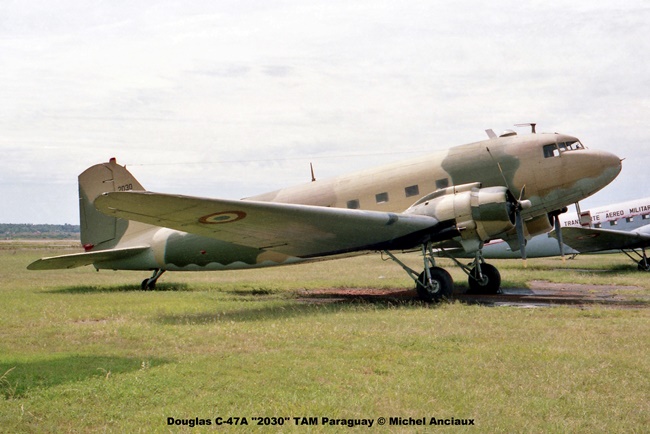





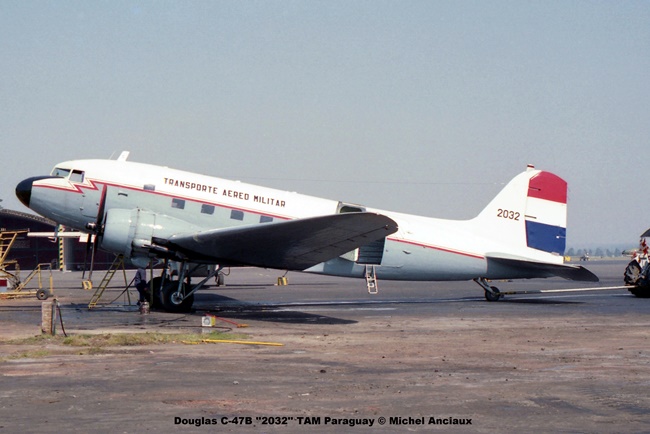


También pude efectuar un vuelo al Chaco con el 2030.


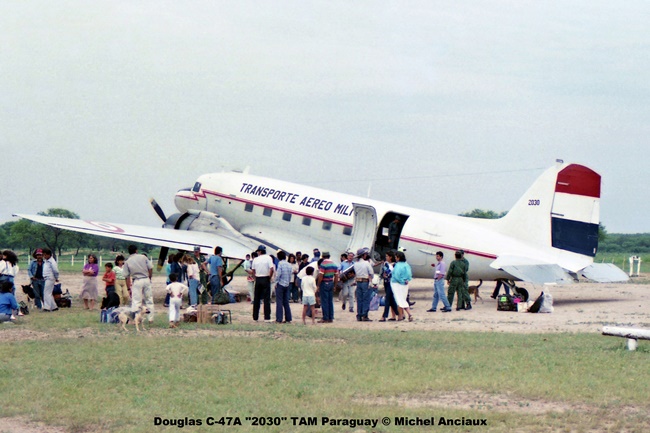

En 1991 se realizó las licitaciones para la venta de todos los materiales y aeronaves que estaban fuera de servicio y que sirvieron, por su mayoría, como fuentes de repuestos.
En dos ocasiones (Julio 1991 y Abril 1994) tuve la oportunidad de visitar y hacer un inventario de los fuselajes de C-47 almacenados en la Base Aérea de Ñu-Guazú en lo que honorablemente llamaría “el cementerio de elefantes”.

Ahora, es de saber que para la mayoría de las aeronaves operando por el mundo, este es el final avece poco gloriosa que les tocan, a menos que pueden terminar en un museo o parque de entretención.






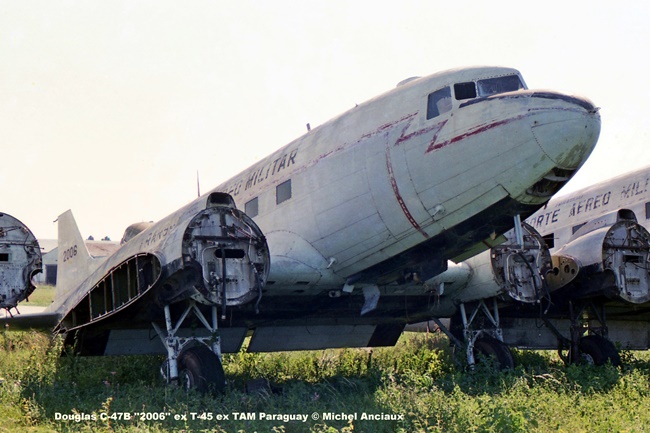



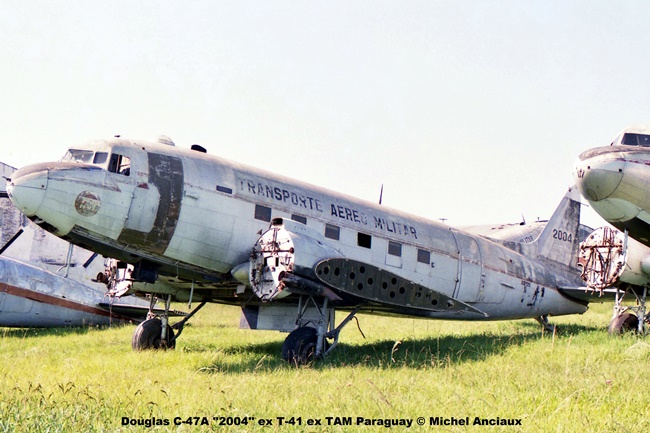






También estaba almacenado el C-47 de la Armada de Paraguay.
En nuestro viaje a Chile en 1973 tuve la oportunidad de fotografiar lo en Buenos Aires mientras operaba con la Armada Argentina.

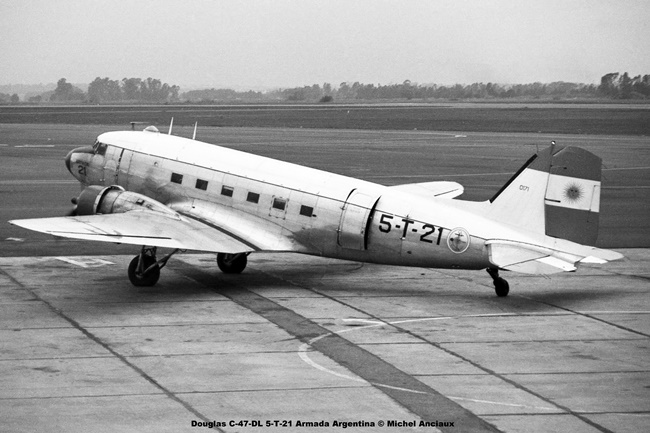
Tres fuselajes fueron utilizados para el entrenamiento básico de los paracaidistas. Se tratan del T-21, el primer Douglas en ser incorporado a la Fuerza Aérea Paraguaya luego el TAM, el T-61 y el T-67.



En mi segunda visita estaban presentes los siguientes Douglas C-47: T-53, T-63 y 2021 así que el C-47 T-26 Armada de Paraguay.

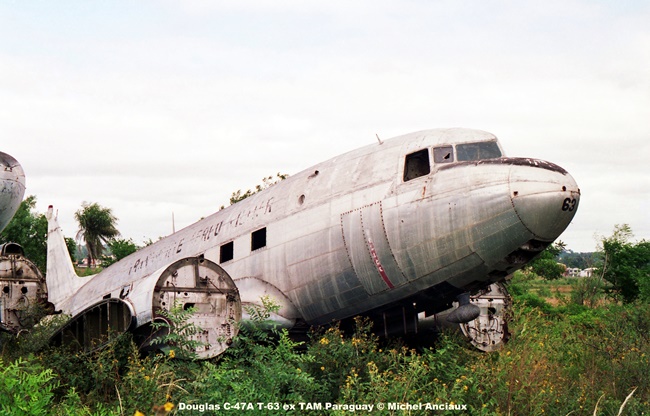





Con los años fueron retirados los C-47 que aún seguían en operación y en 1998 TAM operaba con solo siete aviones, es decir cuatro Aviocar y tres C-47.
Debido a la crisis económica que afectaba el país y los recortes en presupuesto que enfrento entre otras el Transporte Aéreo Militar, este dejo de volar como línea aérea en agosto de 1998 y su dotación de aviones fue transferido al Grupo de Transporte Aéreo (GTA) de la Fuerza Aérea Paraguaya.
Los tres últimos Douglas C-47 siguieron así sus vuelos con el GTA. Los 2030 y 2032 quienes fueron dados de bajas en 1999 y el 2010 que voló por última vez en 2003.




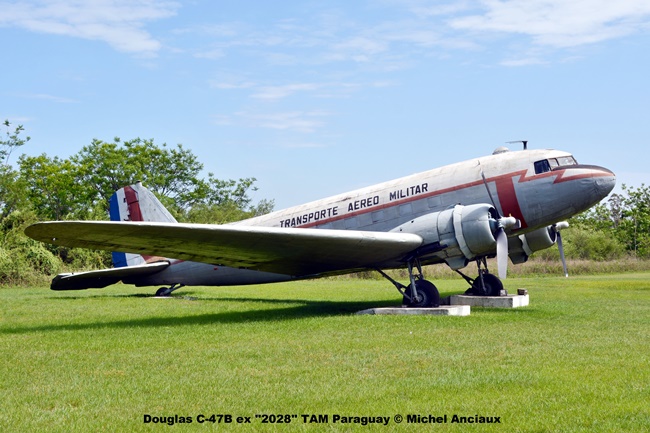
Michel Anciaux

Quiero agradecer Antonio Luis Sapienza por los datos que entrego a fines de realizar esta presentación.
TAM (Transporte Aéreo Militar) de Paraguay is a branch of the Paraguayan Air Force that was established on March 10, 1954, initially operating with a single Douglas DC-3 type aircraft.
With the increase in flight it was necessary to acquire more materials and in 1955 two DC-3A (T-23 and T-25), a C-47A / B (T-27) as well as a R4D-1 ((T-35) entered the TAM fleet, thus increasing the transport of passengers, cargo and mail.
It is to know that in addition to its regular flights to the different cities of the country, TAM also operated flights identified as civic action of transporting food, medicine, seeds and smaller agricultural machinery to the various peasant settlements, without forgetting medical evacuations.
Over the years, more C-47s were registered in the TAM fleet, either through the American Military Aid Program or by donations from the governments of Brazil, Argentina and Chile and throughout the 50 years of operations of this mythical aircraft, 34 DC-3, C-47 and RD4 models flew in TAM (27 C-47, 6 DC-3 and 1 R4D).
Unfortunately, eight accidents, with three fatalities, had to be registered.
The first was in 1965 when the C-47 T-25 caught fire on the ramp of the Encarnación airfield, in a refuelling operation.
The second occurred on June 2, 1965 when on a flight from Asunción to Pedro Juan Caballero with the T-49, the 2 engines failed, necessitating an emergency landing in open terrain. Because of the damage to the cockpit, the pilot in command, Captain Martínez Duarte, died instantly.
The next accident occurred on August 27, 1980 with 2016 after taking off on a flight to Yacyretá (Misiones). Due to problems with the engines, the pilot tried to return to the Asunción international airport but in losing altitude, it crashed into a house in Lambaré, claiming the life of Major PAM Acuña Ramírez.
The fourth accident was on May 1, 1984, when taking off from Concepción in 2019. An engine failure forced the pilot to make an emergency landing, with no fatalities for both the on board crew and the 21 passengers.
In 1987, two additional accidents resulted in the loss of materials but no fatalities. They were 2008 in Bahía Negra and 2034 in Lagerenza.
In 1994, the last two accidents occurred with the Douglas C-47s. On September 26, on a flight from Bahía Negra to Asunción, with the 2009 hit veered of the runway while beginning its take-off. Due to the impact with the ground, the left engine propeller penetrated the fuselage at the level of the cockpit, killing the pilot Mayor PAM Lezcano. He was the last fatal TAM casualty in the C-47’s 50 years of operations.
The last accident occurred on November 24, with 2028, when taking off from Puerto la Victoria, on his final destination to the city of Asunción. The damages resulted is his discharge of service.
In the mid-1970s, the authorities considered the possibilities of replacing the twin-engine C-47. One of the projects that was nearing completion was the Israel Aircraft Industries proposal with its model 201 “Arava”. Even an order for six aircraft was initiated, with possible deliveries beginning in March 1977. However, just one month after this date, the Paraguayan government cancelled the contract.
However, it was in 1984 the purchase of four C.A.S.A. C-212-200 Aviocar was finalised.
In addition, in 1994, the possibilities of remotorizing the Douglas with PT6 turboprop engines were studied, but the economic crisis that affected the country as of 1995 caused this project to be cancelled.
On my first visits to Asunción starting in 1988, I had the opportunity to photograph the five C-47s still in operation.
I was also able to fly to the Chaco in aircraft number 2030.
In 1991, tenders were held for the sale of all materials and aircraft that were out of service and that mostly served as a source of spare parts.
On two occasions (July 1991 and April 1994), I had the opportunity to visit and make an inventory of the C-47 fuselages stored at the Ñu-Guazú Air Base in what I would honourably call “the cemetery of the elephants”.
Now, it should be known that for most of the aircraft operating around the world, this is the inglorious end of their lives unless they can end up in a museum or amusement park.
The C-47 of the Paraguayan Navy was also in storage.
On our trip to Chile in 1973, I had the opportunity to photograph him in Buenos Aires while he was operating with the Argentine Navy.
Three airframes were used for the basic training of the paratroopers. The T-21, that was the first Douglas to be incorporated into the Paraguayan Air Force, then the TAM, the T-61 and the T-67.
On my second visit, the following Douglas C-47s were present: T-53, T-63 and 2021 as well as the C-47 T-26 Armada de Paraguay.
Over the years, the C-47s that were still in operation were withdrawn and in 1998, TAM operated with only seven aircraft, that is, four Aviocar and three C-47.
Due to the economic crisis and the budget cuts that Military Air transport faced, among others, it stopped flying as an airline in August 1998 and its aircraft endowment was transferred to the Air Transport Group (GTA) of the Paraguayan Air Force.
The last three Douglas C-47s thus continued their flights with the GTA. The 2030 and 2032 who were discharged in 1999 and the 2010 who last flew in 2003.
Michel Anciaux
I want to thank Antonio Luis Sapienza for the data that he provided for this presentation.

Estimado Juan
Muy agradecido por su interés y referencia en corregir este error, lo que ya esta echo.
Muy atentamente.
Michel
Me gustaMe gusta